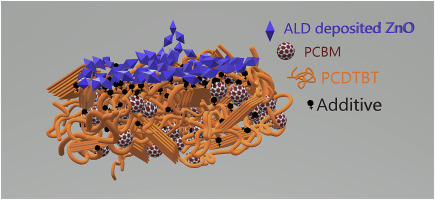Organic Electronics ( IF 2.7 ) Pub Date : 2018-10-04 , DOI: 10.1016/j.orgel.2018.10.002 Hadar Frankenstein , Collen Z. Leng , Mark D. Losego , Gitti L. Frey

|
Interlayers in organic solar cells (OSCs) are used to reduce energy barriers for charge injection/extraction, act as optical spacers, introduce carrier selectivity and increase organic/contact compatibility. To date, the most widely used inorganic interlayers are metal oxides such as TiO2 and ZnO. However, these materials require harsh deposition conditions that could damage the organic active layers, and hence are generally used in inverted devices. Here we show, for the first time, that judicious selection of materials and processing conditions allow the use of an atomic layer deposition (ALD) system to deposit thin conformal ZnO interlayers on bulk heterojunctions (BHJs). ALD-ZnO interlayers were utilized as electron transporting layers (ETLs) in OSCs and compared to similar devices with solution deposited ZnO nanoparticle (np) ETLs. OSCs with ALD-ZnO ETLs exhibited higher photocurrent densities, Jsc, but lower open circuit voltages, Voc. The low Voc is associated with the presence of pinholes and an offset between the ALD-ZnO and PC70BM electron conducting states. This offset results from traps and acceptor sites generated during the low temperature ALD process. To recover the Voc we introduced a fluorinated phosphonic acid (PA) additive to the blend. We suggest that the additive migrates to the film surface, interacts with the ZnO to produce a denser layer and to passivate traps, effectively improving the device shunt resistance and energy level alignment and increasing Voc. Overall, the devices with PA and ALD-ZnO ETLs possess significantly higher power conversion efficiencies (PCEs) than those with np-ZnO ETLs. For example, the champion ALD-ZnO device PCE is 3.5%, while that with np-ZnO is 2.75%.
中文翻译:

ZnO电子传输层的原子层沉积直接沉积到有机太阳能电池的活性层上
有机太阳能电池(OSC)中的中间层用于减少用于电荷注入/提取的能垒,充当光学间隔物,引入载流子选择性并增加有机/接触兼容性。迄今为止,使用最广泛的无机中间层是金属氧化物,例如TiO 2和ZnO。但是,这些材料需要苛刻的沉积条件,可能会损坏有机活性层,因此通常用于倒置器件中。在这里,我们首次展示了对材料和加工条件的明智选择,允许使用原子层沉积(ALD)系统在本体异质结(BHJ)上沉积薄的保形ZnO中间层。ALD-ZnO中间层被用作OSC中的电子传输层(ETL),并与具有溶液沉积ZnO纳米颗粒(np)ETL的类似器件进行了比较。具有ALD-ZnO ETL的OSC表现出较高的光电流密度J sc,但具有较低的开路电压V oc。低的V oc与存在针孔以及ALD-ZnO和PC之间的偏移有关70 BM电子导电态。这种偏移是由于在低温ALD过程中产生的陷阱和受体位点而引起的。为了回收V oc,我们在混合物中引入了氟化膦酸(PA)添加剂。我们建议该添加剂迁移到薄膜表面,与ZnO相互作用以产生更致密的层并钝化陷阱,从而有效地提高器件的分流电阻和能级对准并增加V oc。总体而言,具有PA和ALD-ZnO ETL的器件比具有np-ZnO ETL的器件具有更高的功率转换效率(PCE)。例如,最佳的ALD-ZnO器件PCE为3.5%,而使用np-ZnO的器件为2.75%。











































 京公网安备 11010802027423号
京公网安备 11010802027423号